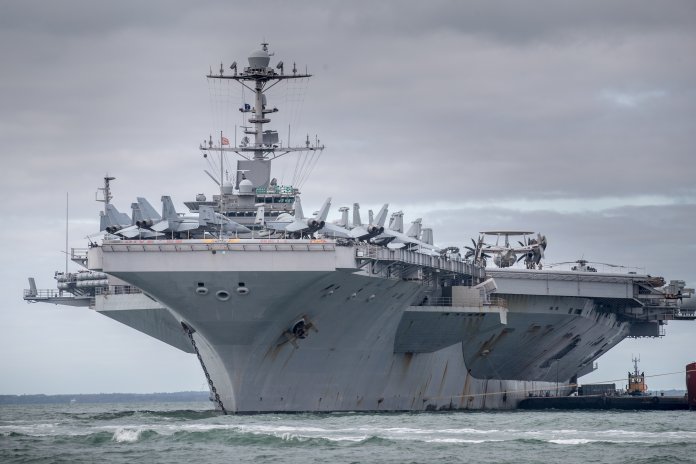WASHINGTON (VM) — The COVID-19 outbreak on the USS Theodore Roosevelt
aircraft carrier led to the quarantine of thousands of sailors, a firing
of captain who pleaded for help, the resignation of the acting U.S. Navy
secretary and broad concerns about the safety of servicemembers confined
to cramped quarters aboard vessels.
Those concerns are acute in Virginia, which is home to six of the
nation’s 11 aircraft carriers and numerous other warships. Three of
those carriers — USS George Washington, USS John C. Stennis and USS
George H.W. Bush — are currently at Naval Station Norfolk, the world’s
largest naval base, according to the Navy.
In addition to the Roosevelt, three other U.S. aircraft carriers have
reported positive cases of COVID-19, Politico reported. They include the
Bremerton, Wash.-based USS Nimitz and USS Carl Vinson; and the USS Ronald
Reagan in Japan. And experts expect it’s likely just a matter of time
before other carriers see infections.
“We’ve got confirmed cases on four carriers, and obviously there’s
ships other than carriers, too,” Sen. Tim Kaine (D-Va.) said in an
interview.
He said it’ll be “very hard to avoid” infections across the U.S.
fleet of aircraft carriers. “This is a global pandemic that is going to
affect every community and every country in the world,” Kaine said. In
the military, “the Navy has been the hardest hit and that’s not a
surprise in a way, because the Navy operates in the closest quarters.”
Former Virginia Democratic Rep. Jim Moran doesn’t expect the widespread
outbreak on the Roosevelt carrier to be a “one off,” he said this week
in an interview.
“Ships and submarines and other parts of the Navy’s fleet are very
susceptible,” added Moran, who served on the U.S. House defense
appropriations subcommittee. “The Navy is known for its cleanliness and
the fact that they scrub everything down, but even so, I think that these
crews are vulnerable.”
Among the branches of the military, the Navy was reporting the highest
number of COVID-19 cases, the Military Times recently reported.
More than 400 sailors assigned to the USS Theodore Roosevelt, which is
docked in Guam, have tested positive for COVID-19, NBC News reported. One
sailor was transferred to an intensive care unit.
“Chances are pretty good that at some point many, if not most, ships in
the Navy are going to have to deal with this type of situation,” said
Brad Martin, a retired U.S. Navy captain who is now a senior policy
researcher for the RAND Corporation.
Cmdr. Ron Flanders, a spokesman for Naval Air Forces, told the Mercury
this week that the Navy has put procedures in place to protect sailors and
their families.
“Personnel are taking the temperature of sailors on the pier, every day,
before they come aboard the ship. If a sailor is showing a fever,
they’re not allowed to come aboard the ship and they’re placed in a
14-day isolation,” Flanders said.
For aircraft carriers in port, when possible, the Navy has significantly
reduced staffing, he said. Many of the members of those carriers’
roughly 3,000-person crews aren’t coming in, using a rotating staffing
system.
Sailors are practicing social distancing and following federal guidance
about handwashing, Flanders said. All Navy ships are conducting frequent
cleaning and disinfecting of handrails, doorknobs and high-traffic areas
multiple times daily. Sailors on aircraft carriers are isolating for 14
days prior to heading to sea, and deployed carriers will spend at least 14
days at sea following a port visit before docking at another port.
Kaine, who serves on the U.S. Senate Armed Services Committee and is the
father of a U.S. Marine, said he’s concerned about COVID-19 impacting
the military in his home state and elsewhere.
“I’m worried about it wherever it is … anywhere it’s affecting the
military or military families or civilians or the contractors, because
they’re all a team. It causes significant concern,” Kaine said.
He and Sen. Mark Warner (D-Va.) wrote aa letter on April 1 to then-Acting
Navy Secretary Thomas Modly posing a series of questions about the
Navy’s readiness to handle COVID-19 outbreaks.
“As you are aware, there are countless Virginians with family members
serving aboard Navy warships who are all concerned about the health and
well-being of their loved ones,” the senators wrote. “We share these
concerns for all our personnel serving in the military at this challenging
time.”
Madly resigned under pressure last week following a backlash after he
removed the commander of the USS Theodore Roosevelt and called him
“stupid” for his response to the outbreak on the ship.
Democratic Rep. Elaine Luria, a 20-year Navy veteran whose 2nd District
includes Naval Station Norfolk, was among the members of Congress who
called for Modly to be fired after his pointed criticism of USS Theodore
Roosevelt Captain Brett Crozier.
“TR sailors are on the frontlines of this pandemic and of our nation’s
defense in the Pacific,” Luria said this week ahead of Modly’s
resignation. “Acting Secretary of the Navy Thomas Modly’s remarks to
the crew show that he is in no way fit to lead our Navy through this
trying time. [Defense] Secretary [Mark] Esper should immediately fire
him.”
Kaine said recently that he hadn’t gotten a response to the questions he
had posed to the Navy. In March, President Donald Trump nominated Kenneth
Braithwaite, his ambassador to Norway, to be the next Navy secretary, but
it’s unclear how quickly the Senate will act on the nomination.
Kaine said there will be time to investigate how the outbreak on the
Roosevelt carrier was handled. The federal government “made huge
mistakes on not doing adequate testing, and the same thing has happened in
the military,” he added.
The absence of testing and the severe shortage of medical equipment, Kaine
said, “can be laid at the feet of an anti-science administration that
told the world that this was not a problem, that it was being overblown by
the media or overblown by Democrats.”
Pentagon officials have stressed that military readiness is not at risk
from the pandemic.
“The U.S. military is very, very capable to conduct whatever operations
are necessary to defend the American people,” Mark Milley, chairman of
the Joint Chiefs of Staff, said Thursday during a Defense Department town
hall. “We are ready today, we’ll be ready tomorrow and we will adapt
ourselves to be able to operate within a COVID-19 environment. We’re
already doing that.”
The Military Times reported earlier last week that the military’s
infection rate was 683-per-million, compared to the general U.S. rate of
932 per million.
“It’s much lower in terms of the rate of infection that you see in our
civilian counterparts,” Defense Secretary Mark Esper said Thursday
during the town hall.
Milley said that the nearly 2,000 confirmed COVID-19 cases in the military
was “not huge,” but he acknowledged that the number will “probably
go up.”



